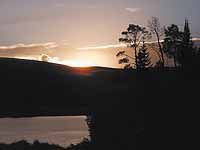| The star gazing group arrive in time to view the sunset in Huntington Canyon. |
Don Burge from the College of Eastern Utah Prehistoric Museum recently led a star gazing session at the Huntington Reservoir in Huntington Canyon. As the darkness gathered the group anxiously awaited the arrival of the stars. Burge passed out two maps to aid star gazers in their quest. He explained the proper use of the map which showed the eastern, southern, northern and western horizon. He said if you are standing facing south then the map you are holding must have the southern horizon pointing downward and the same with the other directions in order to view a true picture of the horizon.
Burge said that the eastern sky is the place where all the action begins and then it takes all night to move across the sky, as the earth is rotating on its axis. Burge explained the cycles of the moon, on this evening the moon was a waxing moon in its second day. He said it was very unusual to ever view a two day moon. But, one sharp eyed amateur astronomer spotted a small sliver of the moon in the western sky which was viewed with amazement from those gathered. Burge explained the difference between the waning and waxing moon. The moon spends 14 days getting smaller which is the waning moon which is also visible during the daylight hours. The moon always faces the sun and has a 29.5 day cycle.
Burge talked about the many nations of the world and how a lot of their calendars are based on the sky and seasons. Each culture seems to have their own names for the constellations in France they call the Big Dipper, La’Casserole; the Ancient Egyptians thought it looked like a crocodile upon a hippo.
Calendars in Christian societies revolve around the birth of Christ. Cultures who do not believe in Christ, such as Iraq or Iran, base their calendars from the time Mohammed had his vision. So what year you’re in depends on where you live. Some cultures have a 20 day week. Ancient Egyptians have three seasons with four months in each. More cultures base their calendars on the stars. Burge described Alexandria, Egypt as the birthplace of science. Alexander the Great has an extensive library of cypress scrolls, a large zoo and an observatory.
Burge described a tour he had taken to Egypt to the Valley of the Kings. In all of the tombs they have detailed maps of the sky on the ceilings. The Egyptian alphabet contains 800 letters many of which are animals.
Burge explained the origin of the days of the week had their start in the heavens. Sun-day, Moon-day which is Monday, Tuesday is named after Mars, Wednesday after Mercury, Thursday after Jupiter, Friday after Venus and Saturday after Saturn.
| Don Burge lectures on the art of star gazing in Huntington Canyon |
Burge explained that the sun, moon and planets follow an ecliptic line in the heavens; an annual path. He explained the signs of the Zodiac and their positions in the sky. Burge mentioned the find of the mammoth at the reservoir on Aug.8, 1988. He said the mammoth was dug up by Nielson’s Construction when they were reinforcing the dam at the reservoir. The mammoth was 50 feet down embedded in clay and boulders. Burge said so far 18 copies of the mammoth have been distributed around the world. It was the most complete mammoth found to date. A copy has been sent as far away as Japan.
Burge remembered the great crowds of people that gathered to see the mammoth on the site, upwards of 5,000 people came. They were given six days to dig up the mammoth and they worked hard to get it out. A short faced bear was also found with the mammoth. Burge said the area surrounding where the mammoth was found is rich in marine life and any good hard rain could wash out just about anything. He said that a mastodon had been found along the Skyline Drive 15-20 years ago and recovered by Wade Miller from Brigham Young University. He said further south along the North Horn the rock is much different and is where the T Rex and other dinosaurs of its type are found. The mammoth bone was real and not fossilized so it had to be kept wet or it could blow up. Burge said they kept the bones originally in his garage where it could be kept wet and his wife had to park her brand new car outside. Burge said the bones must be kept at 69 degrees temperature and 35 percent humidity to maintain them in their present condition.
As the night sky flowed along, the moons around Jupiter were observed and a number of stars and constellations. Many telescopes were set up for the observation of the stars.
Burge said the largest telescope is 236 inches and found in Russia.
Another star gazing session is being planned for August.

